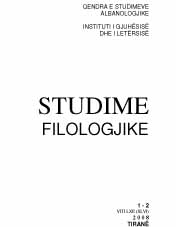Tri koncepte themelore të sintaksës moderne
Three basic concepts of the modern syntax
Author(s): Rami MemushajSubject(s): Language and Literature Studies
Published by: Qendra e Studimeve Albanologjike
Keywords: Three basic concepts ; modern syntax; Albania
Summary/Abstract: Among Albanian linguistic disciplines, syntax is the less developed one. The main reason of this backwardness is the interruption of contacts of our linguistics with developments in European and American linguistics, developments that have been tremendous these last 60 years, especially in the filed of syntax. As a result, for the Albanian students of language a number of key concepts of syntax have remained unknown, at the time when linguists in America and Europe based on these concepts made syntax a pilot discipline for other linguistic sciences. Such concepts are those of exocentric and endocentric constructions, the phrase (syntagma) and valence. The distinction between endocentric constructions (tatpurusha and dwandwa) and exocentric ones (bahuvrihi) were made by old Indian grammarians. These two concepts, which have been used even by our grammarians in the analysis of compound words, were used by Leonard Bloomfield also in the field of syntax. According to him, exocentric constructions are those where “the resultant phrase belongs to the form-class of no immediate constituent”, while endocentric constructions those where “the resultant phrase may belong to the same form-class as its head or center”, and have the same function as its head, as in fresh milk, poor John, which are noun phrases, because their head is a noun (milk, John) and may function as the subject of the sentence: we can say John is pleased or Poor John is pleased. From the introduction of the concept of endocentric constructions in syntax derives the concept of the syntactic phrase, as e syntactic unit between the sentence and the member of the sentence (syntactic word). This new concept was made part of syntactic analysis in the two sides of the Atlantic at the time when our syntacticians operated with only two last units. The concept of togfjalësh, introduced in our syntactic studies in the late sixties by S. Floqi, did not help to describe in depth the syntax of Albanian, because this concept entered under the influence of the Soviet linguistics, represented only one type of phrases, the phrase whose two constituents are meaningful words, that is nouns, adjectives, verbs or adverbs. Consequently, syntactic studies carried by Albanian syntacticians based on this concept did not treat prepositional phrases, phrases with only the heads, such as shirat and po fillojnë in the sentence shirat po fillojnë, or phrases with only one head, as Ecim. Natë etc., those remained unstudied or, in the best case were treated as separate compartments of syntax. The result of all this was that syntactic descriptions of Albanian made till nowadays have lost their coherence and generalization power.
Journal: Studime Filologjike
- Issue Year: 2008
- Issue No: 01-02
- Page Range: 153-170
- Page Count: 18
- Language: Albanian
- Content File-PDF

